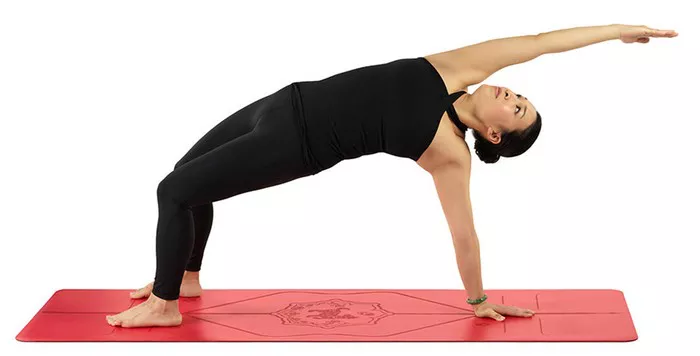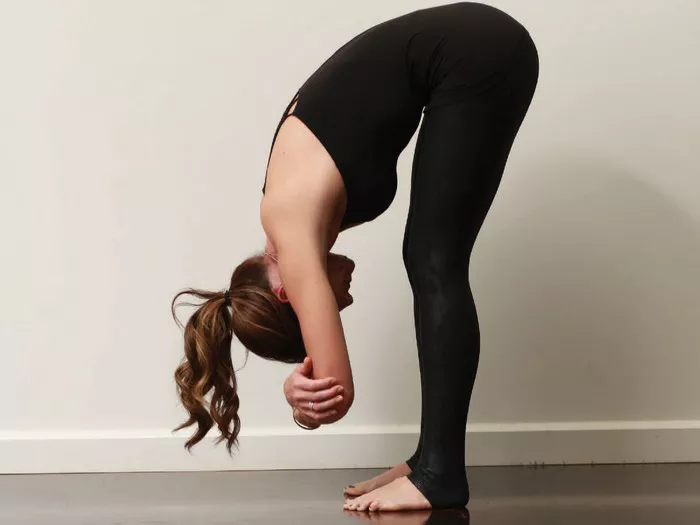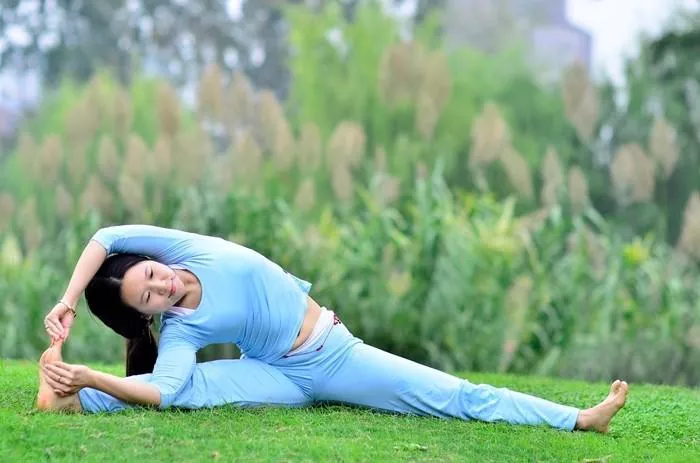In the vast universe of yoga poses, there exists a dynamic and invigorating asana known as Wild Thing Pose, also referred to as Flipped Dog Pose. This pose, with its graceful arc and open heart, embodies qualities of freedom, courage, and exploration. However, like any yoga posture, achieving the full benefits of Wild Thing Pose requires correct alignment, mindful practice, and awareness of potential risks. In this comprehensive guide, we will delve into the intricacies of Wild Thing Pose, offering step-by-step instructions, benefits, precautions, modifications, and suggestions for integration into your yoga practice.
Correct Body Alignment and Form for Wild Thing Pose
Before delving into the pose, it’s crucial to understand the correct alignment to avoid strain or injury. Begin in a high plank position, with your shoulders stacked directly over your wrists, and your body forming a straight line from head to heels. Engage your core muscles to support your spine.
As you transition into Wild Thing Pose, shift your weight onto your right hand and outer edge of your right foot. On an inhalation, lift your hips and extend your left leg behind you, allowing it to float off the ground. Simultaneously, pivot onto the outer edge of your right foot, allowing your body to rotate open towards the left side.
Next, bend your left knee and allow it to drop towards the ground as you reach your left arm overhead, creating a graceful arc with your torso. Your left foot should come to rest on the ground behind you, with your hips lifted towards the sky. Your gaze can follow your fingertips, encouraging a gentle opening through the chest and shoulders.
Ensure that your supporting arm remains strong and stable, with your fingers spread wide to distribute weight evenly. Press firmly through the outer edge of your right foot to maintain balance and stability. Keep your core engaged throughout the pose to protect your lower back and maintain integrity in your alignment.
Step-by-Step Instructions with Clear Visuals
1. Begin in a high plank position, shoulders over wrists, and engage your core.
2. Shift weight onto your right hand and outer edge of your right foot.
3. Inhale, lift hips, and extend left leg behind you.
4. Pivot onto outer edge of right foot, allowing body to rotate open to the left.
5. Bend left knee, allowing it to drop towards the ground.
6. Reach left arm overhead, creating an arc with your torso.
7. Left foot comes to rest on the ground behind you, hips lifted towards the sky.
8. Maintain stability in supporting arm and engage core throughout the pose.
9. Gaze follows fingertips, encouraging opening through chest and shoulders.
Benefits of the Pose
Wild Thing Pose offers a plethora of physical and mental benefits, making it a valuable addition to any yoga practice.
Physical Benefits:
- Stretches and strengthens the shoulders, chest, and upper back, improving posture and relieving tension.
- Opens the hip flexors and quadriceps, promoting flexibility and mobility in the lower body.
- Engages the core muscles, enhancing stability and balance.
- Builds strength in the arms, wrists, and legs, contributing to overall functional fitness.
- Stimulates the cardiovascular system, increasing circulation and energizing the body.
Mental Benefits:
- Cultivates a sense of courage and fearlessness as you explore new movements and sensations.
- Encourages mindfulness and presence as you focus on breath and body awareness.
- Promotes a sense of liberation and freedom as you release tension and open your heart.
- Boosts mood and relieves stress by stimulating the release of endorphins, the body’s natural feel-good hormones.
- Enhances concentration and mental clarity through the integration of breath and movement.
Potential Risks and Contraindications
While Wild Thing Pose offers numerous benefits, it’s essential to approach it mindfully, especially if you have any pre-existing injuries or conditions. Some potential risks and contraindications to consider include:
- Shoulder injuries: Individuals with shoulder injuries or instability should approach Wild Thing Pose with caution. Avoid excessive strain on the shoulders and focus on maintaining stability and integrity in the joint.
- Wrist injuries: Those with wrist injuries or conditions such as carpal tunnel syndrome should be mindful of placing excessive weight on the wrists in this pose. Consider using props or modifying the pose to alleviate pressure on the wrists.
- Neck injuries: Individuals with neck injuries should avoid excessive strain on the cervical spine by keeping the gaze neutral or looking downward rather than craning the neck to look upwards.
- High blood pressure: If you have high blood pressure, take care not to overexert yourself in this pose, as it can elevate heart rate and blood pressure. Practice with awareness and moderation, and consult with a healthcare professional if necessary.
- Pregnancy: Pregnant individuals should avoid deep backbends and twists, making Wild Thing Pose unsuitable during pregnancy. Consider alternative poses that are safe and supportive for prenatal yoga practice.
As with any yoga pose, it’s essential to listen to your body and honor its limitations. If you experience any pain or discomfort, ease out of the pose immediately and seek guidance from a qualified yoga instructor or healthcare professional.
Modifications for Different Skill Levels and Limitations
Wild Thing Pose can be modified to accommodate different skill levels and physical limitations, allowing practitioners to experience the benefits of the pose safely and effectively.
Beginner Modifications:
- Use a yoga block or bolster under the hand for added support and stability.
- Keep the back knee resting on the ground instead of lifting it off the floor.
- Focus on opening the chest and hips without straining the shoulders or wrists.
- Practice the pose against a wall for added support and balance.
Intermediate Modifications:
- Lift the back leg off the ground and extend it fully, engaging the muscles of the leg for added strength and stability.
- Experiment with different arm variations, such as reaching the top arm towards the sky or wrapping it around the back.
- Explore deeper backbending by lifting the hips higher and arching the spine more deeply.
Advanced Variations:
- Transition into Wild Thing Pose from Side Plank or Vasisthasana for an added challenge and fluidity.
- Experiment with transitioning into Wild Thing Pose from Downward-Facing Dog or Three-Legged Dog for a dynamic flow sequence.
- Integrate arm balances or inversions into Wild Thing Pose, such as transitioning into Wild Thing from Side Crow or Handstand.
Preparatory and Counter Poses
To prepare the body for Wild Thing Pose and to counterbalance its effects, incorporate the following preparatory and counter poses into your practice:
Preparatory Poses:
- Downward-Facing Dog (Adho Mukha Svanasana) stretches and strengthens the shoulders, arms, and spine, preparing the body for the arm balance required in Wild Thing Pose.
- Side Plank (Vasisthasana) builds strength in the arms, core, and legs, helping to stabilize the body in the side-lying position of Wild Thing Pose.
- Low Lunge (Anjaneyasana) stretches the hip flexors and quadriceps, preparing the legs for the extended position in Wild Thing Pose.
Counter Poses:
- Child’s Pose (Balasana) gently stretches the back, shoulders, and hips, releasing tension and providing a moment of rest and relaxation after practicing Wild Thing Pose.
- Thread the Needle (Parsva Balasana) releases tension in the shoulders and upper back, counteracting the effects of the backbend in Wild Thing Pose.
- Cat-Cow Pose (Marjaryasana-Bitilasana) mobilizes the spine and engages the core, helping to realign the body after practicing Wild Thing Pose.
Tips for Avoiding Common Mistakes
To maximize the benefits of Wild Thing Pose and minimize the risk of injury, keep the following tips in mind:
- Focus on proper alignment: Ensure that your shoulders are stacked over your wrists, and your hips are lifted towards the sky to maintain stability in the pose.
- Engage your core: Keep your abdominal muscles engaged throughout the pose to support your spine and protect your lower back.
- Relax the neck: Avoid tensing or straining the neck by keeping the gaze soft and the neck in a neutral position.
- Listen to your body: Pay attention to any sensations of discomfort or strain, and adjust the pose as needed to prevent injury.
- Breathe deeply: Maintain a steady and rhythmic breath throughout the pose, allowing it to guide you deeper into the posture while promoting relaxation and focus.
Suggestions for Incorporating the Pose into a Yoga Sequence
Wild Thing Pose can be seamlessly integrated into a variety of yoga sequences, adding a dynamic element to your practice. Here are some suggestions for incorporating the pose into your yoga sequence:
1. Flow sequence: Begin with Sun Salutations (Surya Namaskar) to warm up the body, then transition into a dynamic flow sequence that includes poses such as Downward-Facing Dog, Plank, Side Plank, and Warrior Poses. Integrate Wild Thing Pose between Side Plank and Downward-Facing Dog for a fluid and energizing flow.
2. Heart-opening sequence: Focus on poses that open the chest and shoulders, such as Camel Pose (Ustrasana), Bridge Pose (Setu Bandhasana), and Bow Pose (Dhanurasana). Use Wild Thing Pose as a peak pose to deepen the backbend and expand the heart center.
3. Arm balance sequence: Build strength and stability in the arms and core with poses such as Crow Pose (Bakasana), Eight-Angle Pose (Astavakrasana), and Firefly Pose (Tittibhasana). Transition into Wild Thing Pose from Side Crow or Handstand for a challenging arm balance sequence.
4. Cool-down sequence: Wind down your practice with gentle stretches and restorative poses, such as Child’s Pose, Thread the Needle, and Reclining Spinal Twist (Supta Matsyendrasana). Use Wild Thing Pose as a gentle backbend to counterbalance the effects of forward folds and twists.
Conclusion
By incorporating Wild Thing Pose into your yoga practice, you can cultivate strength, flexibility, and courage while exploring the limitless potential of your body and mind. Whether you’re a seasoned yogi or a curious beginner, let Wild Thing Pose inspire you to embrace your wild side and unleash your inner strength and flexibility.
















